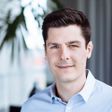How can you summarize context analysis, Flutter, focus time projects, and a master's thesis in one word? Quite simply: xCollect. We will show you through an interview how this all fits together and what xCollect is all about.
The Interview Partners:
Martin Roos, Principal UX Designer
Nicolas Klein, Masterstudent
Dorian Bauer, Principal UX Software Engineer and Flutter Specialist
Malita Pradhani, Senior UX Designer
Esther Barra, Senior Communications Manager
How did the xCollect project start? Which specific problem should be solved?
Martin: Shortly before the pandemic in early 2020, my team manager Christian and I were in the USA for a customer to conduct interviews with their employees, accompany them in their everyday work, and learn from them. These so-called context analyses took place in sessions of 60-90 minutes each, requiring a lot of concentration, communication, and receptiveness. You meet a wide variety of personalities and immerse yourself in their environment.
Especially on a business trip lasting several weeks, it is always more challenging to be fully present with the interviewee — because you only have this chance with the person in front of your microphone, giving you their valuable time.
After dozens of days, locations, and interviews, we found ourselves in a parking lot in Charlotte (USA) on a freezing cold morning for a contextual analysis. At the same time, the wind was so fierce it almost ripped our papers off the clipboard.
At that point, it became clear that the current set-up of a clipboard, paper, pen, recording device, and the like was done. The process of data collection, organization, and subsequent analysis had to be simplified.
How did it go from there?
Martin: At Ergosign, we have a monthly Focus Time, making it possible to work on exciting topics outside the project business. Christian and I first used this to develop the idea further. We used our user-centered design process to develop a problem statement, personas, and scenarios. But it quickly became clear that we needed more time for the project.
So we went to Ergosign's so-called "Innovation Board", where employees can pitch ideas to gain time and resources internally. And we successfully got support from user research and development. Due to the pandemic, some problems and changes caused our project to fall into a deep slumber. This slumber lasted about 18 months until our Flutter expert Dorian had the idea of using xCollect as a topic for a master's thesis.
How did Nicolas come to this topic?
Nicolas: I originally started at Ergosign as a working student, but during the interview, I expressed interest in writing my master's thesis at Ergosign, which, as you can see, was very well received. Dorian supported me in finding a topic for the work. xCollect has been an idea for a long time but had yet to be technically implemented. The subject was a perfect fit because I wanted to develop something for which there was a need and not just write a thesis that would later gather dust on a shelf.
With which technology was the project realized and why?
Nicolas: xCollect was realized with Flutter. Thanks to internal projects such as xDesk and xPark as well as external projects such as the FichtelApp or the Hamburg Süd Shipping App , we at Ergosign have a lot of experience with this. Flutter builds on a single code base — once developed, the application will run on Android, iOS, and, with minor adjustments, also for desktop and web, so cross-platform. You can develop pixel-perfect with Flutter and determine precisely how certain elements should look, which was later pivotal for the visual design team.
Were there different project phases?
Nicolas: The requirement analysis was already provided because of the preparatory work by Martin and Christian. It was then necessary to determine feasible features as part of a master's thesis. We identified key screens and challenges and evaluated them technically based on this.
We also debated usability issues such as the app's vertical or horizontal orientation or which data should be recorded in which form (mp3, mp4, etc.). After the technical evaluation, the app was merged functionally, which, technically, already worked. Only the visual design still needed to be finished. Our colleagues Malita and Alex supported us with the visual design.







